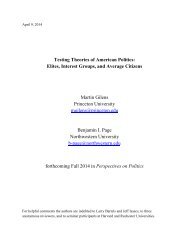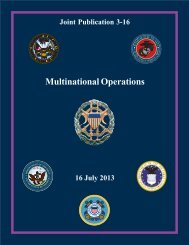ABUSE OF STRUCTURED FINANCIAL PRODUCTS- Misusing Basket Options to Avoid Taxes and Leverage Limits MAJORITY AND MINORITY STAFF REPORT
ABUSE OF STRUCTURED FINANCIAL PRODUCTS- Misusing Basket Options to Avoid Taxes and Leverage Limits MAJORITY AND MINORITY STAFF REPORT
ABUSE OF STRUCTURED FINANCIAL PRODUCTS- Misusing Basket Options to Avoid Taxes and Leverage Limits MAJORITY AND MINORITY STAFF REPORT
You also want an ePaper? Increase the reach of your titles
YUMPU automatically turns print PDFs into web optimized ePapers that Google loves.
91<br />
IV. SYSTEMIC CONCERNS<br />
In its Generic Legal Advice Memor<strong>and</strong>um of November 2010, the IRS rejected the<br />
attempt <strong>to</strong> use basket option structures <strong>to</strong> try <strong>to</strong> convert short-term trading profits in<strong>to</strong> long-term<br />
capital gains with lower tax rates. It also initiated a review of the largest basket options user <strong>to</strong><br />
evaluate its tax liability. While those actions have begun <strong>to</strong> address some of the specific conduct<br />
examined in this investigation, they are incomplete <strong>and</strong> unresolved. The basket option case<br />
studies also raise four larger, systemic concerns.<br />
Invalidating Derivative Tax Schemes. First, the basket option case studies are<br />
emblematic of a larger effort by some tax practitioners <strong>and</strong> sophisticated financial firms <strong>to</strong> claim<br />
that derivatives can be used <strong>to</strong> lower tax liability even when those derivatives mimic economic<br />
activity giving rise <strong>to</strong> taxable income. Treasury, the IRS, <strong>and</strong> Congress need <strong>to</strong> make it clear that<br />
derivatives alone cannot magically eliminate or lower tax liability. As part of that effort, tax<br />
regulations providing special benefits <strong>to</strong> derivatives, such as the U.S. source rule for swaps,<br />
should be revised or eliminated, <strong>and</strong> the message driven home that financial engineering using<br />
derivatives is insufficient <strong>to</strong> avoid income taxation.<br />
Analyzing Circumvention of <strong>Leverage</strong> <strong>Limits</strong>. Second, basket options are just one<br />
example of derivatives <strong>and</strong> other arrangements being used <strong>to</strong> circumvent federal limits on the use<br />
of borrowed funds <strong>to</strong> purchase securities. In the case of RenTec, basket options were used <strong>to</strong><br />
provide it with leverage levels as high as 20:1, which the hedge fund said it had been unable <strong>to</strong><br />
achieve in other settings under federal rules.<br />
In recent years, a few studies have examined how financial institutions, using derivatives,<br />
structured financial products, <strong>and</strong> other arrangements, have weakened or circumvented federal<br />
leverage limits. 495 One recent study by the Office of Financial Research in the Treasury<br />
Department noted that “data [is] currently insufficient <strong>to</strong> underst<strong>and</strong> the exposures <strong>and</strong> the extent<br />
of leverage” being used in the U.S. financial system. 496<br />
The Financial Stability Oversight Council, working with the Office of Financial Research<br />
<strong>and</strong> other federal agencies, should establish new reporting <strong>and</strong> data collection mechanisms <strong>to</strong><br />
gather the data needed for an indepth analysis of the extent of leverage in the U.S. financial<br />
495 See, e.g., 9/2013 “Asset Management <strong>and</strong> Financial Stability,” prepared by the Office of Financial Research<br />
of the U.S. Department of the Treasury, at 1, 17-18<br />
http://www.treasury.gov/initiatives/ofr/research/Documents/<strong>OF</strong>R_AMFS_FINAL.pdf (examining in part asset<br />
management industry use of leverage); Concept Release on Use of Derivatives by Investment Companies,<br />
prepared by the SEC,76 Fed. Reg. 55238 (Sept. 7, 2011) (examining in part investment company use of<br />
derivatives <strong>to</strong> create leverage); 7/6/2010 “ Report of the Task Force on Investment Company Use of<br />
Derivatives <strong>and</strong> <strong>Leverage</strong>,” prepared by the American Bar Association Business Law Section, Committee on<br />
Federal Regulation of Securities, Task Force on Investment Company Use of Derivatives <strong>and</strong> <strong>Leverage</strong>,<br />
https://apps.americanbar.org/buslaw/blt/content/ibl/2010/08/0002.pdf; 2012 “SEC Concept Release Tackles<br />
Investment Company Use of Derivatives,” The Review of Securities & Commodities Regulation, vol. 45,<br />
Jay G. Baris <strong>and</strong> Andrew J. Donohue, http://media.mofo.com/files/Uploads/Images/120308-Securities-<br />
Commodities-Regulation.pdf.<br />
496 9/2013 “Asset Management <strong>and</strong> Financial Stability,” prepared by the Office of Financial Research of the U.S.<br />
Department of the Treasury, at 18, http:<br />
//www.treasury.gov/initiatives/ofr/research/Documents/<strong>OF</strong>R_AMFS_FINAL.pdf.







